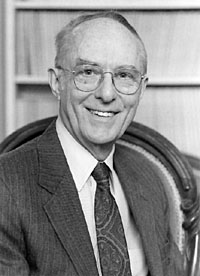Top Qs
Timeline
Chat
Perspective
Frank Anscombe
English statistician From Wikipedia, the free encyclopedia
Remove ads
Francis John Anscombe (13 May 1918 – 17 October 2001) was an English statistician.
Remove ads
Education and career
Born in Hove in England, Anscombe was educated at Trinity College, Cambridge. After serving in the Second World War, he joined Rothamsted Experimental Station for two years before returning to Cambridge as a lecturer.
In experiments, Anscombe emphasized randomization in both the design and analysis phases. In the design phase, Anscombe argued that the experimenters should randomize the labels of blocks.[2][3] In the analysis phase, Anscombe argued that the randomization plan should guide the analysis of data; Anscombe's approach has influenced John Nelder and R. A. Bailey in particular.
Anscombe moved to Princeton University in 1956, and in the same year he was elected as a Fellow of the American Statistical Association.[4] He became the founding chairman of the statistics department at Yale University in 1963.[5][6]
Remove ads
Research

According to David Cox, his best-known work may be his 1961 account of formal properties of residuals in linear regression.[6][7] His earlier suggestion for a variance-stabilizing transformation for Poisson data is often known as the Anscombe transform.[8]
He later became interested in statistical computing, and stressed that "a computer should make both calculations and graphs", and illustrated the importance of graphing data with four data sets now known as Anscombe's quartet.[9] He later published a textbook on statistical computing in APL.[10]
In economics and decision theory, Anscombe is best known for a 1963 paper with Robert Aumann which provides the standard basis for the theory of subjective probability.[11]
Remove ads
Personal life
Anscombe was brother-in-law to another well-known statistician, John Tukey of Princeton University; their wives were sisters.[6]
References
External links
Wikiwand - on
Seamless Wikipedia browsing. On steroids.
Remove ads

